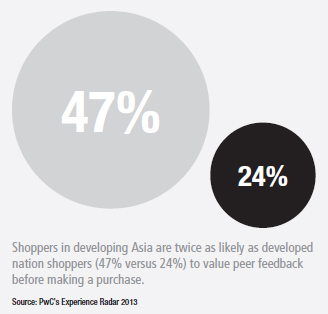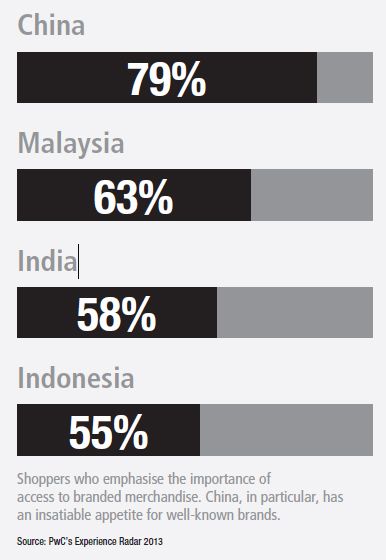



The state of shopper marketing: A tough sale?
share on
With Asia fast on the rise and its people quickly moving up the socio-economic ladder, businesses are moving rapidly to capture the consumer dollar.
With their vastly diverse cultures and ethnicities, these rising consumers are spending big, and showing several distinct cultural preferences in their shopping habits.
In a recent study spanning the markets of the US, Netherlands, Singapore, Indonesia and Malaysia by PriceWaterhouseCoopers, three prevailing trends in Asian shoppers were found.
WHAT THE RISING ASIAN CONSUMER WANTS
First, there is a high emphasis on brands for developing nations in Asia, with consumers stating they are four times more willing to pay for access to branded apparel than shoppers in developed nations.
Also, because family and friends are the foundation of society, a consumer’s network of friends and family is important in influencing shopping decisions.
Finally, most shoppers from developing markets in Asia were more likely to shop online, said the study.
While brands are increasingly seeing the need for good shopper marketing strategies, many remain clueless on what that looks like. Sanjiv Sharma, managing director of JWT’s newly launched shopper marketing arm, JWT Always, says that globally, he sees globally led supermarket brands lead in the shopper marketing arena when it comes to shopper profi ling, occasion-based tracking, in-store placements and other tactics.
“This is really because they have the brand propositions well-defined, the research and insights in place for each market and channel and the resources to implement their overarching campaign strategy well,” he said.
A particular segment that seemed to be lagging behind was consumer IT, he added.
“Walk into any store in Low Yat in KL, Mangga Dua in Jakarta or Pantip in Bangkok and you’ll face a confusing array of laptops with little or no sense of order with regards to the shopper journey or decision tree,” he said.
Markets such as Singapore, Thailand and Malaysia are taking the lead in shopper marketing in Asia, mainly because of their openness and the generally better layered income brackets which demand a greater variety of product SKUs in terms of price and quality. Indonesia is also another market quickly catching up in shopper marketing, said Sharma.
But overall, it seems many brands still struggle to come up with strong marketing strategies.
“Many still execute without knowing what would work best for their retail channels or their shoppers. Also, we fi nd that once a campaign starts, they don’t know what the shopper experience and product propositioning really is like in the aisles, and how shoppers are responding to them,” he said.
question that growing rentals are hurting retailers across the board. Balaji Ramanujam, regional business leader for APAC at 3M, suggests reworking P&Ls will help brands with this.
“Growing rentals can be dealt with by companies reworking their P&Ls to look at how much dollars are going into stores and treat it as marketing spend rather than sales spend. Treat the investment going into the store as marketing,” he said.
He added brands needed to start tracking both the sales impact and the brand building/product awareness driving revenue streams that goes into spends for in-store activities.
“We know that retail/in-store (marketing) are the top two leading drivers of awareness and have, I would say, a great upside impact on brand equity/associations depending on the execution. Everything matters for these two deliverables, including display space, position, product assortment, planogram, creative communication on merchandising, promotions, etc.”
However, in-store expenses get split into top-line deductibles (rental, trade incentives – which drive product assortment) and the creative development/execution part of merchandising that gets accounted for in A&P). Typically, the top-line deductibles component is the bigger amount and doesn’t get held accountable for the “brand and product marketing” aspect of the expenses.
This may change if brands start tracking ROI metrics on total spends in-store and include some relevant key marketing-related metrics linked to the strategies at that point in time.
Of course taking to e-commerce is the most natural alternative for many brands.
“Retail will never die, it will change. So it’s best to be prepared,” said Prashant Agarwal, regional marketing director for APJ at Dell.
However, retailers may see the benefits of adding e-commerce to the mix. For example, UK-based John Lewis saw 35% of online customers using “click and collect”, a method where consumers collect their
purchases from the physical store. Customers also tended to spend more inside stores when picking up online orders, even though John Lewis did little to promote its click-and-collect service. These were examples shared by Michael Kliger, managing director of eBay Enterprise International, at
the company’s e-commerce summit this year.
Another challenge is retail collaboration. Retail partners, if chosen right, can add a lot more value to a brand. But collaboration in this space is not an easy process, said marketers.
While sharing common brand values, ethos and compatible business objectives are key in determining suitable partners for any brand, it is important marketers put in rigorous strategy and planning in managing them.
“We hope everyone is smiling at the end of it. But unfortunately, it is not always as smooth,” said Ruchita Sharma, head of marketing operations and communications of India at Swarovski, alluding to ego issues and communication breakdowns that may occur.
While constant communication is important, things don’t always turn out the way brands hope.
One other challenge is staffi ng and adequate training for staff. Karen Eidsvik, regional director of Asia for Subway, said it was tough to retain talent in the market even after you had trained them.
Subway dealt with this situation through visual merchandising – placing foot prints on the fl oor and a detailed visual menu to explain its products to customers.
“Educating customers this way has helped us achieve greater brand awareness,” she said. Training staff is also a major challenge for brand owners whose front desk staff are consumer-facing. For example, Agarwal shared how customers walking into the Dell store were extremely knowledgeable about
its Alienware programme.
“We have to train our staff to be as savvy if not more and that’s the challenge.”
Canon’s president and chief executive officer Kensaku Konishi echoed the same view. “You don’t want the customer to ask the price and walk away.”
Another big challenge is loyalty and how to drive it.
Nitin Gajria, marketing director of APAC at Mead Johnson Nutrition, said how a brand defi ned loyalty was important. “Loyalty rewards as we know it is dead. Rewarding for being loyal is old-school. You’ve got to win them through relevant rewards.”
Rahul Asthana, marketing director of ASEAN and sector leader for Taiwan, Hong Kong, India and ASEAN at Kimberly-Clark, added that loyalty played an important role in his category. He categorically denied the notion loyalty was dead.
“Loyalty is absolutely essential for brands even today. Perhaps even more so,” he said.
But how brands drive loyalty is important. It’s easy to get lost amid all the data. There is enough data around, but brands face a challenge in consolidating it and gaining insights.
“Data is sitting across many sources. How do brands gather it – that is the main challenge,” said Hywel Evans, regional director of decision science at Aimia.
Some of the other challenges cited by marketers were internal readiness, aligning the product, sales, IT teams operationally, hiring the right talent, coming up with a defi ned objective for the particular execution and integrating it with the overall marketing plan.
While the barriers are obvious, Marketing takes a look at how several brands crafted strong strategies for their brands in the upcoming case studies.
share on
Free newsletter
Get the daily lowdown on Asia's top marketing stories.
We break down the big and messy topics of the day so you're updated on the most important developments in Asia's marketing development – for free.
subscribe now open in new window


